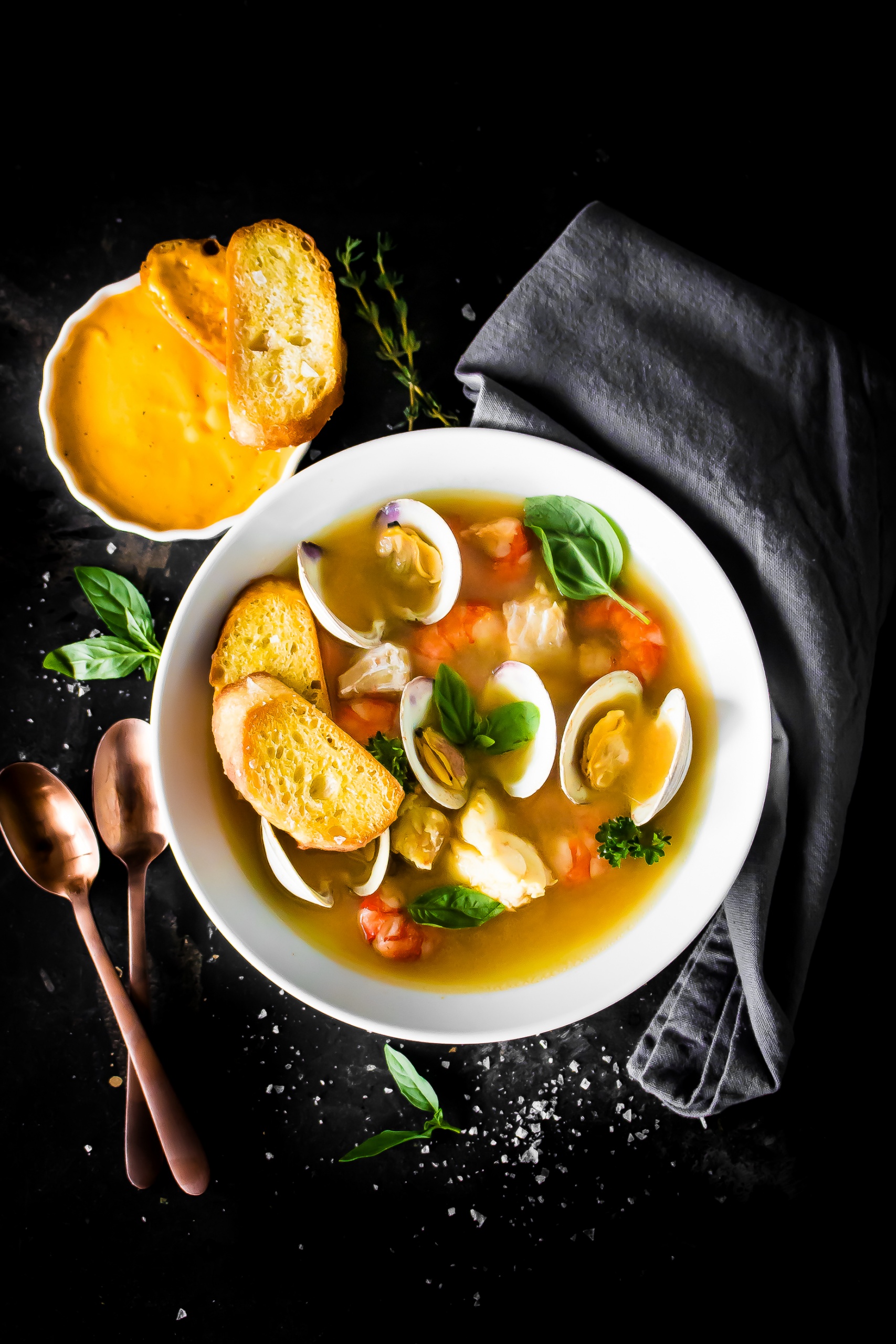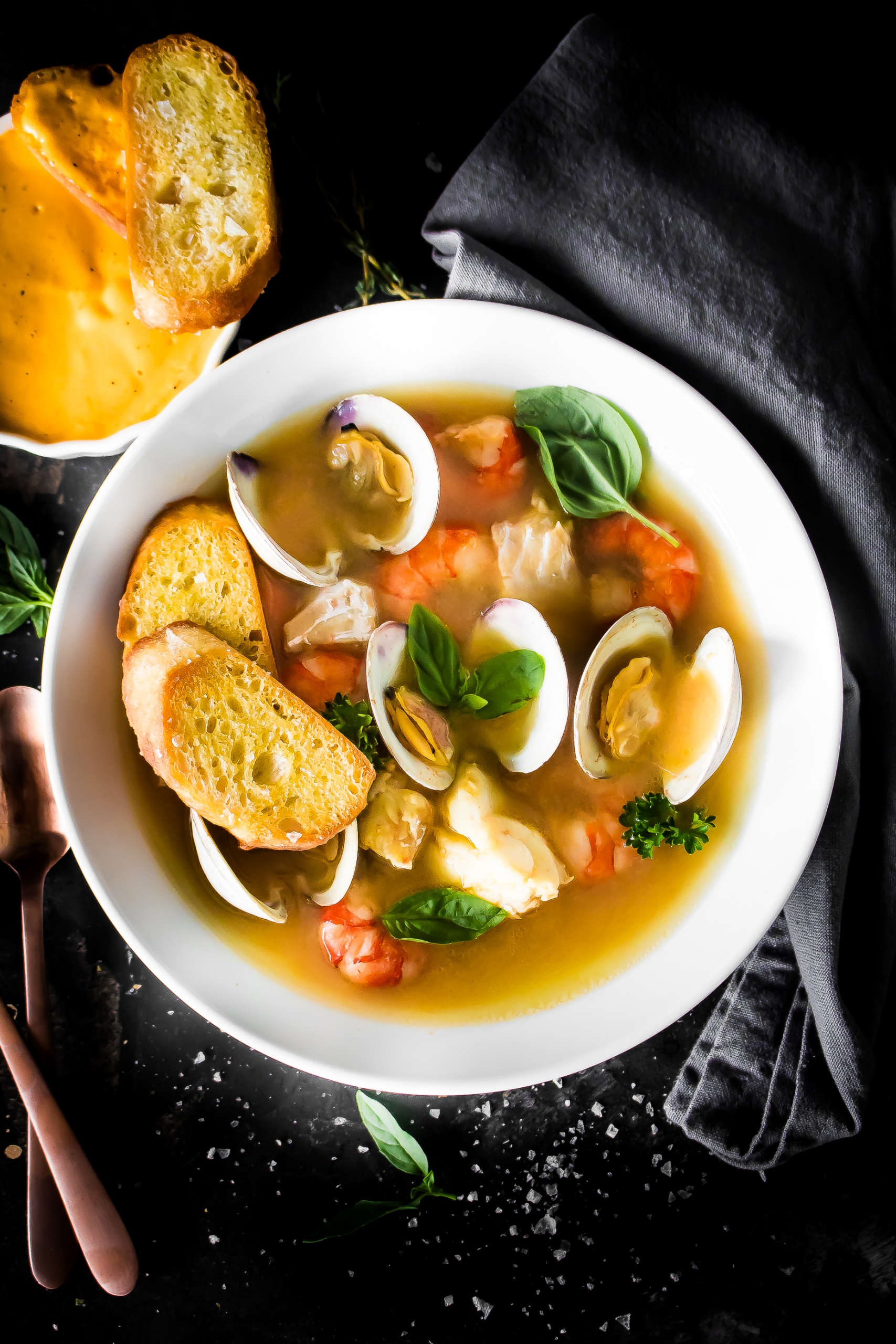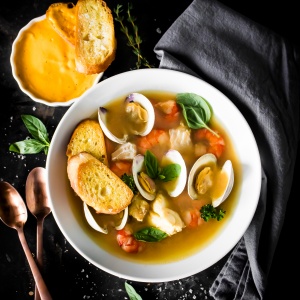This spring, you can still enjoy soups with a lighter and refreshing look, and this Bouillabaisse definitely fits the bill as a classic spring menu item.

Spring is finally here! It’s quite the transition from braising meats, to soups and fresh green vegetables. So when I passed by my fishmonger after running some errands, I had to walk in. I ended up buying some fresh fish and shellfish. I’m talking whole branzino and seabream, cod filets, mussels, clams, shrimp and even squid. Although I didn’t use all of it in my bouillabaisse, there is a good amount of seafood in this light but hearty stew; after all it wouldn’t be a bouillabaisse without it!

The origins of bouillabaisse are quite humble. Bouillabaisse (pronounced “boo-ya-bese”) is a rustic fish stew from the Provençal port city of Marseille. Although it is made in many regions in France, it has also evolved into other variations in North America, like Cioppino, which hails from San-Francisco.

The key method to making a successful bouillabaisse is using fish stock, which you will have to make. You may find store-bought fish stock, but that simply won’t cut it, (sorry!). You can make the fish stock in advance and freeze it for later use for the bouillabaisse. It’s so simple! So don’t fret. The process is worth it and once you’ve tried it, you won’t want it any other way.

Another key ingredient paired with authentic bouillabaisse is a Rouille, which is an emulsified sauce similar to mayonnaise. It’s traditionally made with egg yolks, olive oil, breadcrumbs, saffron, garlic and cayenne pepper. Some variations, like this recipe, use roasted red peppers, lemon, and even substitute almond flour for breadcrumbs. Other recipes like this one omit the breadcrumbs altogether, since it’s traditionally served with toasted baguettes.

Lastly, it is essential that you use a stock pot to make this dish. If you do not have a stock pot, get your hands on one. There are affordable brands on Amazon or you can even get them at thrift stores. Otherwise, a very large Dutch oven can be used.
- ¼ cup extra-virgin olive oil
- 1 small red onion, chopped
- 1 large leek, chopped
- 2 celery stalks, chopped
- 4 cloves garlic, diced
- 2 cups canned chopped tomatoes
- 2 ½ quarts water
- A bouquet garni of fresh basil, parsley and thyme
- Peel of one mandarin, orange or tangerine
- A generous pinch (1 tsp) of crumbled saffron
- Kosher salt and ground black pepper, to taste
- 1 fish head and carcass from any round fish (get it from your fishmonger)
- 1 lb shrimp shells
- 1 lb cod or halibut filet, cubed into large chunks
- 1 lb jumbo shrimp, peeled (save shells for stock)
- 1 lb large clams, scrubbed
- ½ cup dry white wine
- Toasted baguettes, for rouille
- Rouille:
- 1 large garlic clove, crushed
- ½ a roasted red bell pepper, seeded
- 1 large egg yolk
- Juice of half a lemon
- A pinch of saffron threads
- 1 cup extra-virgin olive oil¼ tsp harissa
- Kosher salt to taste
- In a stock pot over medium heat, heat the olive oil. Add in the onion, leek and celery and cook for 2 minutes until softened. Stir in the garlic and cook for a minute until slightly fragrant, then add the chopped tomatoes, water, bouquet garni, mandarin peel, saffron, salt (season generously), pepper, fish head, carcass and shrimp shells. Bring to a gentle boil, then reduce the heat to medium-low and cook for 30-35 minutes. Keep tasting your broth and season with more salt as desired.
- When ready, discard the vegetables using a spider strainer, or strain the broth into a large pot and discard the veggies. Using a spider strainer is easier so you don’t have to pour the broth back into the stock pot.
- Bring the strained stock to a boil, then add the fish and shrimp and cook for about a minute. Add the clams and white wine, then cover and simmer until the clams open, about 2-4 minutes. Remove from heat and set aside when cooked.
- To make the rouille, combine all the rouille ingredients (except the olive oil) in a food processor. Gently add in the olive oil, about 3 tablespoons at a time, or a slow drizzle while blending the ingredients, depending on the type of food processor you have. Keep blending until you get a creamy texture similar to a smooth mayonnaise. This can take anywhere from 5 minutes to 15 minutes depending on the food processor you have.
- Keep in mind that once the rouille is done, it will continue to set and thicken at room temperature since the heat from blending can make it semi-loose, so once you get a creamy consistency that coats the back of your spoon, it’s ready. Let the rouille set at room temperature or in the refrigerator for about 10 minutes.
- Serve the bouillabaisse with toasted baguettes and rouille.




